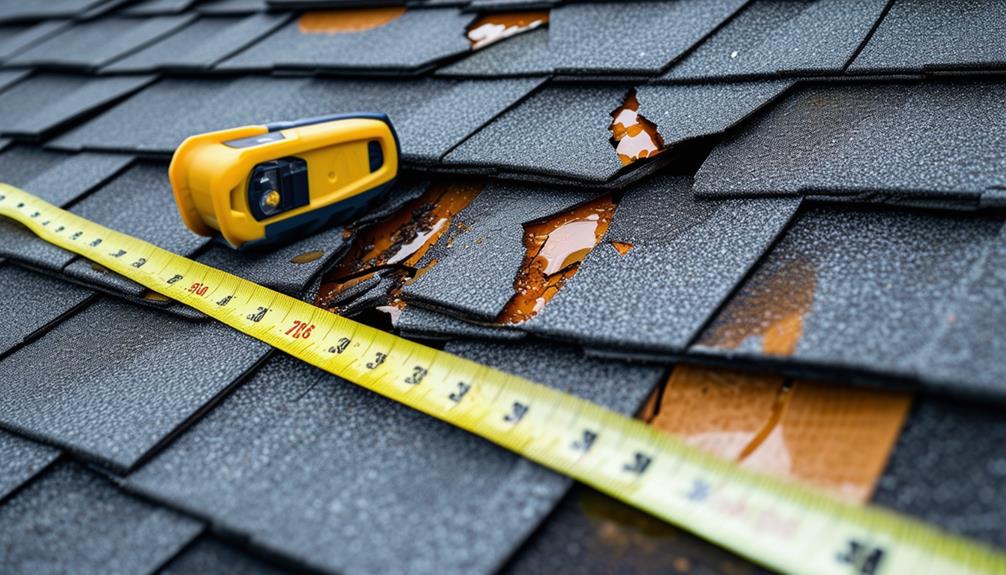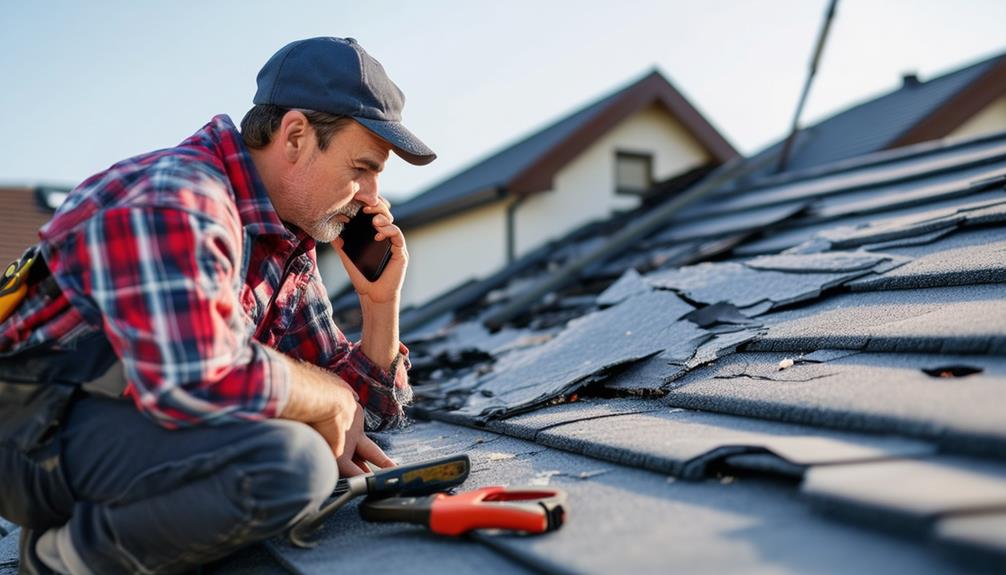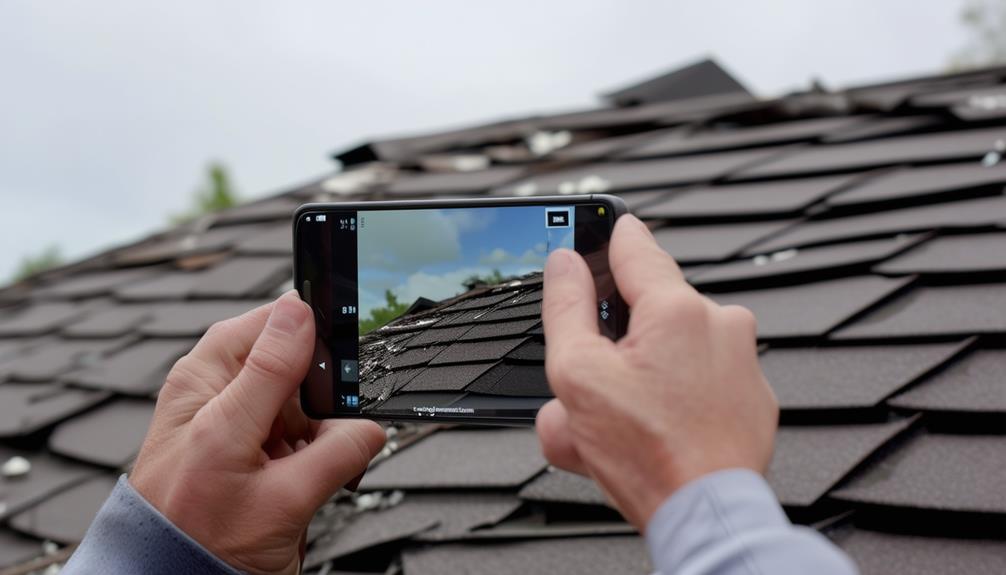When facing emergency roof repairs, start by evaluating the damage thoroughly. Look for visible signs like water damage or debris. Use temporary patching techniques like roof tarping or sealants to shield and fix smaller leaks. Consider calling a professional roofer for expertise and quality repairs. Protect your belongings by salvaging items and storing them in a secure, dry place. Document the damage with detailed photographs, focusing on cracks and leaks. Taking swift actions and following these steps can prevent further damage.
Assessing the Roof Damage

To begin addressing the emergency roof repairs, carefully examine and assess the extent of the damage to your roof. Start by conducting a thorough roof inspection to identify any visible signs of damage such as missing or cracked shingles, water stains on the ceiling, or sagging areas. It is important to evaluate the overall condition of the roof to determine the best course of action.
During the damage evaluation, pay close attention to any areas that may be prone to leaks or structural issues. Look for signs of water damage, mold growth, or rot, as these can indicate more severe underlying problems. Take note of any debris or foreign objects that may have caused damage to the roof.
Temporary Patching Techniques
Inspecting the extent of damage to your roof, you may need to employ temporary patching techniques to prevent further issues before a permanent repair can be made. One effective method is roof tarping, which involves covering the damaged area with a sturdy tarp to shield it from the elements temporarily. Make sure the tarp is securely fastened to prevent it from being blown off by wind or rain.
Additionally, sealants can be used to patch up smaller leaks or cracks in the roof. Apply the sealant carefully to the affected area, following the manufacturer's instructions for the best results. DIY repairs can be a quick fix, but remember to prioritize safety. Always work with a partner, use proper safety equipment like gloves and goggles, and avoid working on the roof during adverse weather conditions.
While temporary patching techniques can provide immediate relief, it's important to remember that they are not permanent solutions. Be sure to contact a professional roofer as soon as possible to assess the damage and perform a thorough repair to prevent further issues.
Calling a Professional Roofer

Consider reaching out to a reputable roofing professional to address the damage and guarantee a proper and lasting repair. When dealing with roof issues, it's essential to have the expertise of a professional to safeguard the safety and integrity of your home. Here are some key points to keep in mind when contacting a professional roofer: Make sure to request a detailed roof repair cost breakdown upfront to avoid any unexpected expenses and ensure transparency in the pricing. A skilled roofer can assess the extent of the damage, recommend the best materials, and provide a timeline for the repairs. Clear communication about your needs and expectations will help ensure the project is completed efficiently and to your satisfaction.
- Roof Inspection: A professional roofer will conduct a thorough inspection of the damage to assess the extent of the problem and recommend the best course of action.
- Repair Options: Based on the inspection findings, the roofer will present you with various repair options tailored to your specific needs and budget.
- Experience and Expertise: Professional roofers have the necessary experience and expertise to handle a wide range of roofing issues efficiently and effectively.
- Quality Materials: They will use high-quality materials that meet industry standards to ensure a durable and long-lasting repair.
- Guarantee: Reputable roofers often provide guarantees on their work, giving you peace of mind that the repair is done right.
Protecting Your Belongings
When facing roof damage, ensuring the protection of your belongings becomes a critical priority. Salvaging valuables and preventing further damage are essential steps during this challenging time. Start by safely removing valuable items from affected areas. This includes electronics, important documents, jewelry, and sentimental objects. Place these items in a secure, dry location away from the water. Utilize plastic bins or bags to protect them from potential leaks or debris.
To prevent further damage, cover furniture with plastic sheets or tarps to shield them from water exposure. If water has already seeped into carpets or upholstery, try to dry them as much as possible to avoid mold growth. Place buckets under any active leaks to collect water and minimize spreading.
Documenting the Damage

Document the extent of the damage by taking detailed photographs and videos of the affected areas and items. This step is vital in providing photographic evidence for insurance claims and ensuring a smooth process for repairs. Here are some essential tips for documenting the damage effectively:
- Capture Different Angles: Take photos and videos from multiple angles to provide a thorough view of the damage.
- Focus on Details: Zoom in on specific areas to highlight the severity of the damage, such as cracks, leaks, or missing shingles.
- Include Date Stamps: Make sure that the date and time stamp feature on your camera or phone is activated to provide accurate documentation.
- Document Belongings: Don't forget to photograph any damaged belongings or furniture inside your home to include in your insurance claim.
- Backup Your Files: Make sure to store your photographic evidence in a safe place or cloud storage to prevent loss or damage.
Frequently Asked Questions
Can I Use a Tarp as a Long-Term Roof Repair Solution?
It is crucial to use a tarp as a temporary patch for roof repairs. However, for a long-term solution, it is recommended to combine it with a waterproof sealant. This will provide better protection against the elements and extend the tarp's effectiveness. Remember, while a tarp can offer a quick fix, addressing the underlying issue promptly is important to prevent further damage to your roof.
How Can I Prevent Roof Leaks During Heavy Rain?
To prevent roof leaks during heavy rain, maintaining your roof is essential. Regular roof maintenance, such as checking for loose shingles or damaged flashing, can help identify potential issues before they become major problems. Additionally, consider waterproofing techniques like applying sealants or coatings to vulnerable areas. By staying proactive and addressing maintenance needs promptly, you can better protect your roof from leaks during heavy rain.
Are There Any DIY Tools Specifically for Roof Repairs?
Looking to tackle roof repairs yourself? Safety precautions are essential. Do you have the right tools for the job? DIY roof repairs often require basic tools like a hammer, utility knife, and caulking gun. Make sure to have roofing materials on hand, such as shingles, flashing, and roofing cement. Stay safe, and follow proper techniques for a successful repair.
Should I Check My Insurance Coverage for Roof Repairs?
When considering roof repairs, it's important to check your insurance coverage. Review your policy to understand what it includes regarding roof repairs. Familiarize yourself with the process of making an insurance claim, ensuring you have the necessary coverage. Additionally, explore alternatives like using tarps for temporary fixes until permanent repairs can be made. Being proactive and informed about your insurance can save you time and money when dealing with roof damage.
How Do I Know if the Roof Damage Is Extensive?
When evaluating roof damage, it's like peeling an onion, revealing layers of potential issues. To know if the damage is extensive, conduct a thorough roof inspection. Look for signs like missing shingles, water stains, or sagging areas. If unsure, consider hiring professionals for a detailed evaluation. Their expertise can pinpoint hidden problems and provide recommendations for necessary repairs. Don't delay in addressing potential extensive damage to prevent further issues.
Conclusion
After following these steps, you can rest assured that your roof is in good hands. Remember, a small leak can quickly turn into a big problem if not addressed promptly. By taking action and seeking professional help when needed, you can prevent further damage to your home and belongings. So, don't wait until it's pouring rain to address your roof issues – take charge and protect your sanctuary from the storm.




